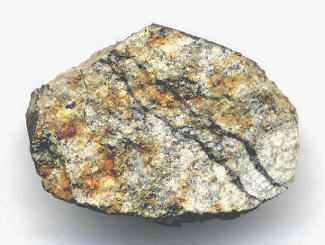Park Forest
L5 fragmental brecciaWork in Progress ... A rock that is a mechanical mixture of different minerals and/or rock fragments (clasts). A breccia may also be distinguished by the origin of its clasts: (monomict breccia: monogenetic or monolithologic, and polymict breccia: polygenetic or polylithologic). The proportions of these fragments within the unbrecciated material Click on Term to Read More
Fell in 2003, March 26 at 11:50 P.M.
41° 29′ 05′ N., 87° 40′ 45′ W.
As midnight neared, ending the last Wednesday of March, 2003, a terrific fireballA fireball is another term for a very bright meteor, generally brighter than magnitude -4, which is about the same magnitude of the planet Venus as seen in the morning or evening sky. A bolide is a special type of fireball which explodes in a bright terminal flash at its end, often with visible fragmentation. Click on Term to Read More passed overhead on its long approach path. Following a SSW to NNE trajectory, the fireball put on a fiery display for residents of several states including Missouri, Illinois, Indiana, Michigan, and Ohio, ultimately delivering sonic detonations as multiple fragmentation events occurred at altitudes of 37, 29, and 22 km. Hundreds of fragments ended their journey in the southern suburbs of Chicago, showering the towns of Crete, Park Forest, and Olympia Fields with stones weighing from a few grams to 5.26 kg. Many of these fragments impacted cars, homes, lawns, sidewalks, streets, and even the local Fire Station, giving many unsuspecting residents an opportunity to recover a fresh meteorite—and others an opportunity to repair their damaged windows, roofs, and other structures.
Joining these resident ‘meteoriteWork in progress. A solid natural object reaching a planet’s surface from interplanetary space. Solid portion of a meteoroid that survives its fall to Earth, or some other body. Meteorites are classified as stony meteorites, iron meteorites, and stony-iron meteorites. These groups are further divided according to their mineralogy and Click on Term to Read More hunters’ were some cosmochemists from local institutions, including the University of Chicago, the Chicago Field Museum, and the Argonne National Laboratory. Among the many meteorite collectors and dealers who traveled to the fallMeteorite seen to fall. Such meteorites are usually collected soon after falling and are not affected by terrestrial weathering (Weathering = 0). Beginning in 2014 (date needs confirmation), the NomComm adopted the use of the terms "probable fall" and "confirmed fall" to provide better insight into the meteorite's history. If Click on Term to Read More location was Steve Arnold (International Meteorite Brokerage; ‘Meteorite Men’), along with his wife Qynne and two young daughters Kelsey and Lauren. All of the Arnold’s found meteorites during their trip—the first ever meteorite finds for Qynne, Kelsey and Lauren. 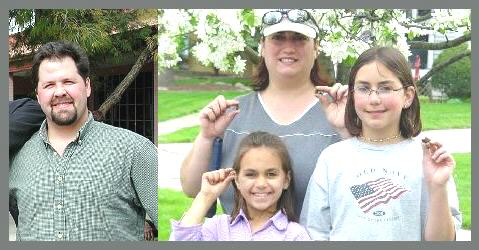 The Park Forest meteorite shown at the top of the page was one of several found by Lauren, and it was subsequently put up for sale via eBay auction. The story behind her findMeteorite not seen to fall, but recovered at some later date. For example, many finds from Antarctica fell 10,000 to 700,000 years ago. Click on Term to Read More, written by Lauren herself, inspired my own bid—but in the end, I lost out to fellow collector Mike Fowler. Remarkably, three years later, this 3.5 g specimen is in the Weir Collection thanks to Mike’s generosity. Lauren’s personal account of the successful Arnold Family meteorite expedition follows:
The Park Forest meteorite shown at the top of the page was one of several found by Lauren, and it was subsequently put up for sale via eBay auction. The story behind her findMeteorite not seen to fall, but recovered at some later date. For example, many finds from Antarctica fell 10,000 to 700,000 years ago. Click on Term to Read More, written by Lauren herself, inspired my own bid—but in the end, I lost out to fellow collector Mike Fowler. Remarkably, three years later, this 3.5 g specimen is in the Weir Collection thanks to Mike’s generosity. Lauren’s personal account of the successful Arnold Family meteorite expedition follows:
‘Hi, my name is Lauren Arnold, I’m 11 years old. My Dad has been in the meteorite business my whole life, but until now I have never had a chance to hunt meteorites with him. Several weeks ago a big meteorite broke up and landed all over Chicago and my Dad went up to find some. He found a lot of them. So on his third trip to Chicago, my sister, my Mom and I talked him into taking us with him.
We made a deal that we had to keep our first meteorite we found, but we could sell the others. After getting to the motel the first day, we went to Burger King and both my sister and I got a Kid’s Meal, and guess what was the toy in them? A huge meteorHow long Sonic booms Of the several 10s of tons of cosmic material entering Earth's atmosphere each day, only about one ton reaches the surface. An object's chance of survival depends on its initial mass, speed and angle of entry, and friability (tendency to break up). Micrometeoroids radiate heat so Click on Term to Read More! It came with a Superman Doll and a comic book. My Dad was so excited, and he read the comic book to us and it was about Superman finding a bunch of meteors after lunch. Dad told us ‘You know what that means don’t you? It is a sign that we are going to find a bunch of meteorites today.’
Well I found two that day, my sister found one and so did my Mom. The next couple of days we each found several more. We are all keeping our first ones, but we are selling the rest. Well, my Dad is selling them for us. But we get to keep the money! So bid real high because these are special. Oh, and we went back to Burger King that night and bought some more of the Kid’s Meal toys, so you also get one free included with each of our special meteorites we are selling if you are lucky enough to be the high bidder. I hope the toy brings you as much luck as it did us.’
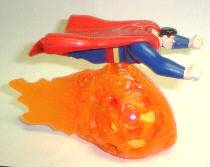
Burger King Superman-Meteor Kid’s Meal toy
Park Forest was analyzed and classified at the University of Chicago (S. Simon), the Field Museum of Natural History (M. Wadhwa), and the Planetary Studies Foundation (P. Sipiera). Park Forest has olivineGroup of silicate minerals, (Mg,Fe)2SiO4, with the compositional endpoints of forsterite (Mg2SiO4) and fayalite (Fe2SiO4). Olivine is commonly found in all chondrites within both the matrix and chondrules, achondrites including most primitive achondrites and some evolved achondrites, in pallasites as large yellow-green crystals (brown when terrestrialized), in the silicate portion Click on Term to Read More Fa and pyroxeneA class of silicate (SiO3) minerals that form a solid solution between iron and magnesium and can contain up to 50% calcium. Pyroxenes are important rock forming minerals and critical to understanding igneous processes. For more detailed information, please read the Pyroxene Group article found in the Meteoritics & Classification category. Click on Term to Read More Fs contents consistent with the L-group ordinary chondritesChondrites are the most common meteorites accounting for ~84% of falls. Chondrites are comprised mostly of Fe- and Mg-bearing silicate minerals (found in both chondrules and fine grained matrix), reduced Fe/Ni metal (found in various states like large blebs, small grains and/or even chondrule rims), and various refractory inclusions (such Click on Term to Read More; O-isotopic ratios also confirm this classification (Simon et al., 2004). In accord with the scheme of Van Schmus and Wood, Park Forest is classified as a petrologic typeMeasure of the degree of aqueous alteration (Types 1 and 2) and thermal metamorphism (Types 3-6) experienced by a chondritic meteorite. Type 3 chondrites are further subdivided into 3.0 through 3.9 subtypes. 5. Park Forest is a strongly shocked (S5) monomict brecciaType of breccia whose clasts are composed of a single (mono-) rock type, possibly all from a single rock unit (e.g., L6 with L6). Monomict breccias are rare on the Moon because meteoroid impacts tend to mix different kinds of rocks. The example is a terrestrial granite breccia. Image Source: consisting of light gray clasts within a darker matrixFine grained primary and silicate-rich material in chondrites that surrounds chondrules, refractory inclusions (like CAIs), breccia clasts and other constituents. Click on Term to Read More. It contains scattered FeNi-metal flakes throughout, while FeS veins occur only in the dark lithology, which is considered to be derived from the light lithology through impact shock processes that mobilized sulfides.
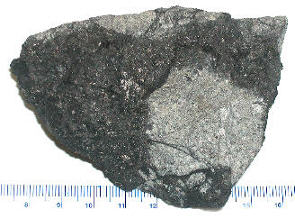
Park Forest stone exhibiting both light and dark lithologies
Photo courtesy of The University of Chicago News Office
Orbital, velocity, trajectory and pre-atmospheric mass data of the Park Forest bolideA very bright fireball that breaks apart in the atmosphere with a minimum brightness approximately equivalent to the full moon. Click on Term to Read More were obtained from U.S. Department of Energy and Department of Defense satellites, with additional information supplied by ground-based video camera and seismic and acoustic instruments (Brown et al., 2004). SatelliteBody in orbit (such as a moon) around another larger body (such as a planet or star). Click on Term to Read More data indicate that the meteoroid’s entry velocity fell from an initial maximum of ~20 km/sec above 60 km, to ~14 km/sec at lower altitudes. Seismic and acoustic measurements infer a total energy equivalent to ~0.4–0.5 kilotonnes of TNT. This is an Apollo-type asteroid with a heliocentricCentered around a sun. Our own Solar System is centered around the Sun so that all planets such as Earth orbit around the Sun. Note that 25% of Americans incorrectly believe the Sun revolves around the Earth. Click on Term to Read More orbitThe elliptical path of one body around another, typically the path of a small body around a much larger body. However, depending on the mass distribution of the objects, they may rotate around an empty spot in space • The Moon orbits around the Earth. • The Earth orbits around Click on Term to Read More and an aphelionPoint farthest from the sun in a body's elliptical orbit. Click on Term to Read More that likely coincides with the 3:1 mean-motion resonance with Jupiter at 2.50 AUThe astronomical unit for length is described as the "mean" distance (average of aphelion and perihelion distances) between the Earth and the Sun. Though most references state the value for 1 AU to be approximately 150 million kilometers, the currently accepted precise value for the AU is 149,597,870.66 km. The Click on Term to Read More. Cosmogenic radionuclideRadioactive isotope - Atomic nuclide that decays radioactively . Click on Term to Read More measurements indicate that the pre-atmospheric mass of Park Forest was between 900 and 7,000 kg, with the higher value being consistent with a model based on porosityThe volume percentage of a rock that consists of void space. Vesicular porosity is a type of porosity resulting from the presence of vesicles, or gas bubbles, in igneous rock such as the pumice presented here. Vesicular porosity is very rare in meteorites and is often associated with slag, one Click on Term to Read More. Based on a gross fragmentation model, it could be argued that Park Forest was initially a meteoroidSmall rocky or metallic object in orbit around the Sun (or another star). ~2 m in diameter with a pre-atmospheric mass of ~14,000 kg. In their compilation of measurement techniques, Brown et al. (2004) derived an initial pre-atmospheric mass estimate of 11,000 (±3,000) kg and a diameter of 1.8 m. Meier et al. (2017) conducted a re-analysis of cosmogenic radionuclides and noble gasElement occurring in the right-most column of the periodic table; also called "inert" gases. In these gases, the outer electron shell is completely filled, making them very unreactive. Click on Term to Read More abundances for Park Forest, and their new data, consistent with that of two established models, provided the following results:
- a pre-atmospheric mass of 1,730–5,870 kg
- a pre-atmospheric diameter of 1.06–1.76 m
- a porosity of 0–40%
- a densityMass of an object divided by its volume. Density is a characteristic property of a substance (rock vs. ice, e.g.). Some substances (like gases) are easily compressible and have different densities depending on how much pressure is exerted upon them. The Sun is composed of compressible gases and is much Click on Term to Read More of 2.0–3.4 g cm–3
In addition, Meier et al. (2017) determined that the radiogenic gas retention ages ([U, Th]–He and K–Ar) for Park Forest are consistent with that of the catastrophic disruption of the L chondriteOrdinary chondrites low in free Ni-Fe metal (4 to 10 vol. %), containing olivine (Fa22-26) and the orthopyroxene hypersthene (Fs19-22). Average chondrule diameters (0.7 mm) are larger than those in H chondrites. The asteroid 433 Eros is suspected as a parent body, based on reflectance spectra, but most L chondrites Click on Term to Read More parent bodyThe body from which a meteorite or meteoroid was derived prior to its ejection. Some parent bodies were destroyed early in the formation of our Solar System, while others like the asteroid 4-Vesta and Mars are still observable today. Click on Term to Read More, an event dated at 470 (±6) m.y. ago as attested by the abundance of fossil L chondrites and associated chromiteBrownish-black oxide of chromium and iron (Cr-Fe oxide), Cr2FeO4, found in many meteorite groups. Click on Term to Read More grains recovered from Mid-Ordovician limestoneA common form of calcium carbonate (CaCO3). Other common forms of CaCO3 include chalk and marble. Click on Term to Read More quarries in Sweden and other countries (see the Beenham page for more information). Meier and Welten (2014) determined that Park Forest lacks solar windSupersonic flow of high-speed charged particles continuously blowing off a star (mostly e- and p+). When originating from stars other than the Sun, it is sometimes called a "stellar" wind. The solar wind may be viewed as an extension of the corona into interplanetary space. The solar wind emanates radially noble gasesElement occurring in the right-most column of the periodic table; also called "inert" gases. In these gases, the outer electron shell is completely filled, making them very unreactive. Click on Term to Read More, which indicates it is not a regolithMixture of unconsolidated rocky fragments, soil, dust and other fine granular particles blanketing the surface of a body lacking an atmosphere. Regolith is the product of "gardening" by repeated meteorite impacts, and thermal processes (such as repeated heating and cooling cycles). Click on Term to Read More breccia but is instead a fragmental breccia. They determined a 21Ne-based CRE age of ~17 m.y., and found that various radiometric chronometers had been reset in the relatively recent past. Meier et al. (2017) conducted a re-analysis of the cosmogenic noble gases for Park Forest, and their results gave a CRE age of 12 (±1) m.y. based on 3He, and 14 (±2) m.y. based on 21Ne and 38Ar.
Park Forest is one of a growing number of meteorites with a precisely calculated orbit (e.g., Pribram, Innisfree, Lost City, Peekskill, Neuschwanstein, Morávka, Tagish Lake, Novato). Meier et al. (2017) assert that the location of the L chondriteChondrites are the most common meteorites accounting for ~84% of falls. Chondrites are comprised mostly of Fe- and Mg-bearing silicate minerals (found in both chondrules and fine grained matrix), reduced Fe/Ni metal (found in various states like large blebs, small grains and/or even chondrule rims), and various refractory inclusions (such Click on Term to Read More parent body at the time of breakup was near the Jupiter 5:2 mean motion resonance (signifying the ratio between the orbital periodThe length of time it takes an orbiting object to make one complete trip around its primary body. The Earth’s orbital period around the Sun is 1 year and the Moon's is one 27.3 days. Mercury's orbital period is ~88 days (closest to the Sun) and Neptune's is ~165 years Click on Term to Read More of Jupiter and that of an asteroid) from which rapid delivery from the inner asteroid beltBelt located between 2.12 and 3.3 AU from the Sun and located between the orbits of Mars and Jupiter containing the vast majority of asteroids. The asteroid belt is also termed the main asteroid belt or main belt to distinguish it from other asteroid populations in the Solar System such Click on Term to Read More to an Earth-crossing orbit could be attained, consistent with the CRE age calculated for the fossil L chondrites recovered from mid-Ordovician limestone quarries. Based on spectrographic and mineralogical data for more than 1,000 near-Earth asteroids, Binzel et al. (2016) determined the probable main beltBelt located between 2.12 and 3.3 AU from the Sun and located between the orbits of Mars and Jupiter containing the vast majority of asteroids. The asteroid belt is also termed the main asteroid belt or main belt to distinguish it from other asteroid populations in the Solar System such Click on Term to Read More source region for each of the ordinary chondriteWork in Progress Ordinary chondrites (OCs) are the largest meteorite clan, comprising approximately 87% of the global collection and 78% of all falls (Meteoritical Society database 2018)1. Meteorites & the Early Solar System: page 581 section 6.1 OC of type 5 or 6 with an apparent shock stage of S1, Click on Term to Read More groups (see diagram below).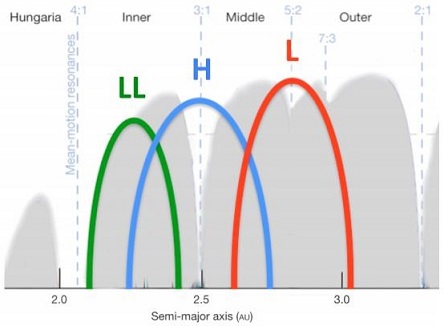
Diagram credit: Binzel et al., 47th LPSC, #1352 (2016) Thereafter, L chondrite material would have been delivered to the more efficient, albeit slower, 3:1 resonance (and the less important ν6 secular resonance) where transfer to Earth occurred over an extended period of millions of years. The S-type asteroids of the Gefion family have been historically considered a probable source for the L chondrites. However, in consideration of such factors as pre-breakup size, breakup age, and shock-darkening history of the parent asteroid, Meier et al. (2017) contend that the Ino asteroid family may be a more plausible source (see the Beenham page for further details). Utilizing surface thermal conductivity estimates for the Park Forest meteoroid, they calculated its possible orbital evolution following its ejection ~14 m.y. ago. They conclude that its delivery to Earth was either directly through the 5:2 resonance or that it migrated to the 3:1 resonance buried at a significant shielding depth within a larger meteoroid.

Diagram credit: Meier et al., MAPS, vol. 52, p. 1563 (2017)
‘Park Forest (L5) and the asteroidal source of shocked L chondrites’
(http://dx.doi.org/10.1111/maps.12874) The total recovered weight of the Park Forest meteorite is only ~30 kg out of a predicted ground fall mass of up to 150 kg. The specimen shown at the top is a 3.53 g half stone which was broken upon impact; dark shock veins can be seen traversing the light gray lithology. The photo below is an excellent petrographic thin sectionThin slice or rock, usually 30 µm thick. Thin sections are used to study rocks with a petrographic microscope. micrograph of Park Forest shown courtesy of Peter Marmet.

click on image for a magnified view
Photo courtesy of Peter Marmet
For additional information on the Park Forest fall, read the PSRD article by Linda M.V. Martel—’Meteorite Shower in Park Forest, Illinois‘, Aug 2004.






